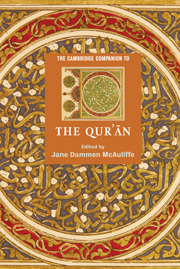Book contents
- Frontmatter
- Introduction
- Part I Formation of the Qur'ānic text
- 1 The historical context
- 2 Creation of a fixed text
- 3 Alternative accounts of the Qur'ān’s formation
- Part II Description and analysis
- Part III Transmission and dissemination
- Part IV Interpretations and intellectual traditions
- Part V Contemporary readings
- Qur'ān Citation Index
- General Index
1 - The historical context
from Part I - Formation of the Qur'ānic text
Published online by Cambridge University Press: 28 March 2007
- Frontmatter
- Introduction
- Part I Formation of the Qur'ānic text
- 1 The historical context
- 2 Creation of a fixed text
- 3 Alternative accounts of the Qur'ān’s formation
- Part II Description and analysis
- Part III Transmission and dissemination
- Part IV Interpretations and intellectual traditions
- Part V Contemporary readings
- Qur'ān Citation Index
- General Index
Summary
The Qur'ān, considered by believing Muslims to be a literal transcript of God's word as revealed to the prophet Muhammad (c. 570-632 CE), poses a number of interesting, and sometimes vexing, questions when we attempt to discuss its historical context. In one sense, the Qur'āan's theological status as divine word negates the very idea of it having a historical context at all, for it implies that the text is of eternal and unchanging validity. Muslim tradition even asserts that it had been revealed on several other occasions, to earlier communities via their prophets. This being so, the historical context in which a particular passage was revealed to Muhammad can be understood only as an accident, and has no real bearing on the meaning of a passage at all, which is immutable and intrinsic.
Despite the Qur'ān's theological status, Muslims over the centuries elaborated highly detailed traditions about the Qur'ān's historical context. This took the form of a vast biographical literature on the Prophet and his time which, loosely following traditional usage, we can call the sīra literature. The sīra literature was compiled by Muslim sages during the several hundred years following Muhammad's death in 11/632, and offers a richly detailed account of Muhammad's life, of his receipt of the revelations that are enshrined in the Qur'ānic text, and (although less fully) of the codification of the revelation in the years following his death to produce the text of the Qur'ān as we have it today. Most Western scholarship on the Qur'ān and its context has drawn heavily on the sīra literature for its basic documentation.
- Type
- Chapter
- Information
- The Cambridge Companion to the Qur'ān , pp. 23 - 40Publisher: Cambridge University PressPrint publication year: 2006
- 4
- Cited by



